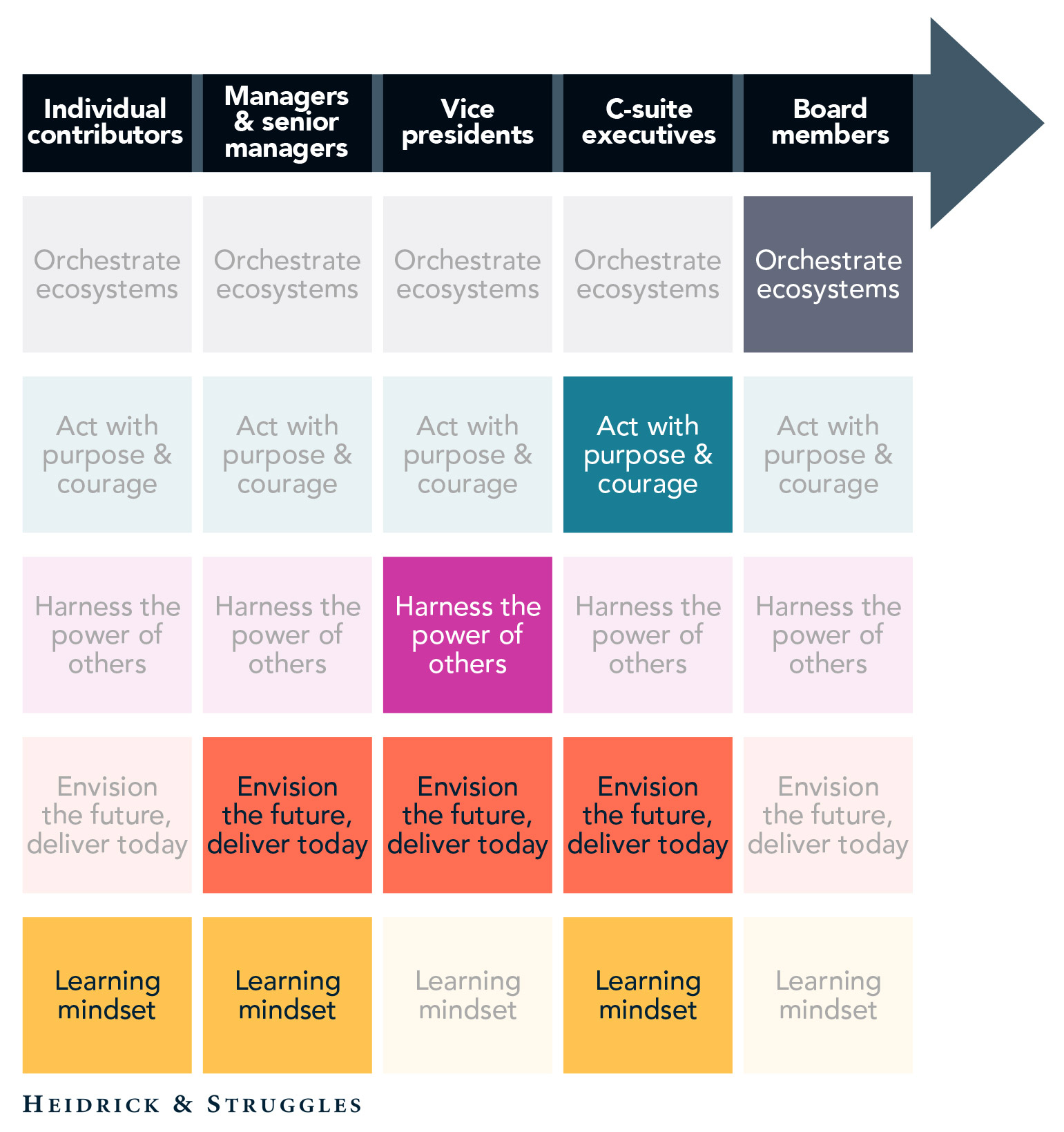Leadership Development
How connecting leader imperatives help at each level of leadership
The 2025 confidence monitor from Heidrick & Struggles shows that only 10% of CEOs and board members are entirely confident in their overall executive attraction, development, and retention strategy, but two-thirds of CEOs are promoted from within the organization. The fact that so many leaders emerge internally underscores the critical importance of developing a strong leadership pipeline.
That pipeline must include leaders who are currently effective in their role and who also have potential for the future. Today the boundaries of organizations are blurring in ways that make connections among people and organizations more important than ever, while also making them more complicated than ever. Strong leaders must possess the ability to connect, person to person, both within and across their organization’s ecosystem, even as it changes. They help leaders bring together a diverse mix of people with the right skills, capabilities, and mindsets to build a purpose-driven organization with an agenda that is bigger than any one of them or any single organization. Through our work, we have identified five imperatives that leaders can adopt and, over time, become what we call connecting leaders. These imperatives are as follows:
- Act with purpose and courage
- Harness the power of others
- Orchestrate ecosystems
- Envision the future, deliver today
- Adopt a learning mindset
In our work with companies, we have seen that when leaders implement the five imperatives, the imperatives build on each other and affect leaders’ perceived impacts differently. This article explores how these imperatives build on one another to drive expanded leadership capabilities.
The additive nature of connecting leader skills
As leaders progress through the organizational hierarchy, the capabilities that matter most evolve. What’s striking in the data is the additive nature of the connecting leader skills: as roles increase in complexity and scope, additional leadership behaviors become critical to success. In fact, there’s a strong positive correlation between leadership impact and future potential, suggesting that the same foundational behaviors fuel both present-day performance and long-term growth. For example, embracing a learning mindset is not only a way to elevate performance now—it’s a strategy for building a strong, future-ready leadership bench.
At the individual contributor level, learning mindset stands out as the sole significant predictor of potential. This early emphasis on continuous development lays the foundation for growth—but alone, it’s not enough for success at higher levels. As individuals step into manager and senior manager roles, one more dimension emerges as critical in addition to learning mindset: envision the future, deliver today. Leaders at this level must balance current priorities while also beginning to think more strategically about what lies ahead.
For vice presidents, the leadership equation continues to expand. In addition to being able to envision the future and deliver results in the present, their ability to harness the power of others becomes a key differentiator. At this level, leaders must lead through others, build aligned teams, and create momentum across functions.
By the time leaders reach the C-suite, three connecting leader capabilities stand out as significant: learning mindset; envision the future, deliver today; and act with purpose and courage. The demands of executive leadership require a blend of strategic foresight, operational excellence, personal growth, and principled decision-making under pressure. Interestingly though, for boards of directors, only one behavior is statistically significant: an executive’s ability to orchestrate ecosystems. Boards are concerned not with managing operations or strategy execution, but with shaping and governing the broader system in which the organization operates.
The pattern is clear: as responsibilities increase, the required leadership skill set becomes broader and more complex. The progression isn't about replacing one behavior with another—it’s about building on top of what came before. The most effective leaders continuously expand their capabilities to meet the evolving demands of their roles.
Connecting imperatives for a robust leadership pipeline
The ability to understand which capabilities colleagues see as key to success at each level of leadership can be a powerful way to shape leadership development priorities. Of course, executives planning leadership development and succession planning work must also consider specific skills and capabilities leaders in their organization need, and their starting point.1
But by understanding how the importance of connecting leader capabilities evolve across leadership levels—and which behaviors have the greatest impact—organizations can help ensure their leaders have the foundational capabilities that matter most at every level. By fostering a strong culture of curiosity and continuous growth with a learning mindset throughout the enterprise, organizations can begin to expand the pool of individuals ready to lead.
About the authors
Dr. Regis Chasse (rchasse@heidrick.com) leads leadership development solutions initiatives for Heidrick Consulting; he is based in the Washington D.C. office.
Dr. Keith McCook (kmccook@heidrick.com) is a Senior Director of Psychology, Product Research, & Design at Heidrick & Struggles; he is based in the Chicago office.
Dr. Leah Houde (lhoude@heidrick.com) is a partner in Heidrick Consulting; she is based in the Washington, D.C. office.
Reference
1 For more on this, see Steven Krupp, “Developing future-ready leaders: From assessments to strategically aligned learning,” Heidrick & Struggles, February 16, 2023, heidrick.com; and Sarah Arnot, Sharon Sands, and Todd Taylor, “Leadership assurance: How data can improve every aspect of executive leadership development and succession planning" Heidrick & Struggles, July 31, 2024, heidrick.com.
